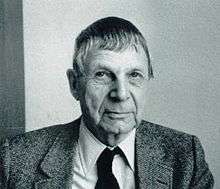Lars Ahlfors
| Lars Ahlfors | |
|---|---|
 Lars Ahlfors | |
| Born |
18 April 1907 Helsinki, Finland |
| Died |
11 October 1996 (aged 89) Pittsfield, Massachusetts, U.S.A. |
| Nationality | Finnish |
| Fields | Mathematics |
| Institutions |
University of Helsinki ETH Zurich Harvard University |
| Alma mater | University of Helsinki |
| Doctoral advisor |
Ernst Lindelöf Rolf Nevanlinna |
| Doctoral students |
Paul Garabedian James A. Jenkins Albert Marden (de) Robert Osserman Henry Pollak Halsey Royden George Springer Eoin Whitney |
| Known for | Riemann surfaces |
| Notable awards |
Fields Medal (1936) Wihuri Prize (1968) Wolf Prize in Mathematics (1981) Leroy P. Steele Prize (1982) |
Lars Valerian Ahlfors (18 April 1907 – 11 October 1996) was a Finnish mathematician, remembered for his work in the field of Riemann surfaces and his text on complex analysis.
Background
Ahlfors was born in Helsinki, Finland. His mother, Sievä Helander, died at his birth. His father, Axel Ahlfors, was a professor of engineering at the Helsinki University of Technology. The Ahlfors family was Swedish-speaking, so he first attended a private school where all classes were taught in Swedish. Ahlfors studied at University of Helsinki from 1924, graduating in 1928 having studied under Ernst Lindelöf and Rolf Nevanlinna. He assisted Nevanlinna in 1929 with his work on Denjoy's conjecture on the number of asymptotic values of an entire function. In 1929 Ahlfors published the first proof of this conjecture, now known as the Denjoy–Carleman–Ahlfors theorem. It states that the number of asymptotic values approached by an entire function of order ρ along curves in the complex plane going toward infinity is less than or equal to 2ρ.
He completed his doctorate from the University of Helsinki in 1930.
Career
Ahlfors worked as an associate professor at the University of Helsinki from 1933 to 1936. In 1936 he was one of the first two people to be awarded the Fields Medal. In 1935 Ahlfors visited Harvard University. He returned to Finland in 1938 to take up a professorship at the University of Helsinki. The outbreak of war led to problems although Ahlfors was unfit for military service. He was offered a post at the Swiss Federal Institute of Technology at Zurich in 1944 and finally managed to travel there in March 1945. He did not enjoy his time in Switzerland, so in 1946 he jumped at a chance to leave, returning to work at Harvard where he remained until he retired in 1977; he was William Caspar Graustein Professor of Mathematics from 1964. Ahlfors was a visiting scholar at the Institute for Advanced Study in 1962 and again in 1966.[1] He was awarded the Wihuri Prize in 1968 and the Wolf Prize in Mathematics in 1981.
His book Complex Analysis (1953) is the classic text on the subject and is almost certainly referenced in any more recent text which makes heavy use of complex analysis. Ahlfors wrote several other significant books, including Riemann surfaces (1960)[2] and Conformal invariants (1973). He made decisive contributions to meromorphic curves, value distribution theory, Riemann surfaces, conformal geometry, quasiconformal mappings and other areas during his career.
Personal life
In 1933, he married Erna Lehnert, an Austrian who with her parents had first settled in Sweden and then in Finland. The couple had three daughters.
See also
Bibliography
- Complex Analysis: an Introduction to the Theory of Analytic Functions of One Complex Variable (1953,[3] 1966, 1979) (ISBN 0-07-000657-1)
- Contributions to the Theory of Riemann Surfaces: Annals of Mathematics Studies (1953) (ISBN 0-691-07939-0) (co-author and co-editor)
- Ahlfors, Lars (February 1966). "FUNDAMENTAL POLYHEDRONS AND LIMIT POINT SETS OF KLEINIAN GROUPS". Proceedings of the National Academy of Sciences. 55 (2): 251–254. doi:10.1073/pnas.55.2.251. PMC 224131
 . PMID 16591331.
. PMID 16591331.
References
- ↑ Institute for Advanced Study: A Community of Scholars
- ↑ Springer, George. "Review of Riemann surfaces. By Lars V. Ahlfors and Leo Sario" (PDF). Bull. Amer. Math. Soc. 67 (2): 170–171. doi:10.1090/S0002-9904-1961-10548-X.
- ↑ Schaeffer, A. C. (1953). "Review: Complex analysis. By Lars V. Ahlfors" (PDF). Bull. Amer. Math. Soc. 59 (5): 464–467. doi:10.1090/S0002-9904-1953-09722-1.
External links
- Lars Ahlfors at the Mathematics Genealogy Project
- Ahlfors entry on Harvard University Mathematics department web site.
- Papers of Lars Valerian Ahlfors : an inventory (Harvard University Archives)
- Lars Valerian Ahlfors The MacTutor History of Mathematics page about Ahlfors
- The Mathematics of Lars Valerian Ahlfors, Notices of the American Mathematical Society; vol. 45, no. 2 (February 1998).
- Lars Valerian Ahlfors (1907–1996), Notices of the American Mathematical Society; vol. 45, no. 2 (February 1998).
- Frederick Gehring (2005). "Lars Valerian Ahlfors: a biographical memoir" (PDF). Biographical Memoirs. 87.
- National Academy of Sciences Biographical Memoir
- Author profile in the database zbMATH